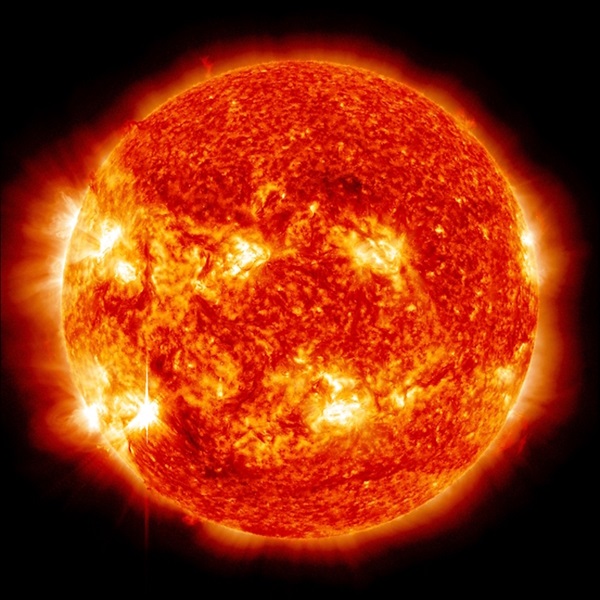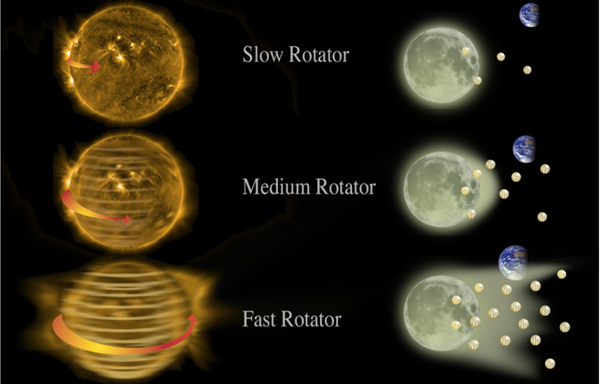But when stars are young, they rotate more quickly and less predictably. Two stars of the same size may rotate at drastically different speeds. And stars that are fast rotators tend to shoot out more solar flares and coronal mass ejections, hurling powerful radiation and charged particles into their systems, often to the detriment of the planets around them.
Researchers from NASA’s Goddard Space Flight Center, led by Prabal Saxena, published a study May 3 in the Astrophysical Journal Letters, where they used the Moon’s surface to measure just how active our Sun was in its early years, a factor that strongly determined how the inner planets, including Earth, evolved.
Solar blast
Learning about the Sun’s past based on how fast it once turned is difficult. “After a billion years,” says Saxena, “[stars with the same mass] all converge to the same rotation rate. There’s few clues as to what your state was before,” if all you have to measure is the star itself. But Saxena’s team found a workaround by focusing on potassium and sodium in lunar samples. Although Earth and the Moon are made of the same material, these elements exist in smaller amounts on the Moon compared to Earth. But sodium and potassium do still exist in lunar samples, in large enough amounts that they’re easy to track and measure.
Sodium and potassium are volatiles, meaning they’re easily ripped off the lunar surface by strong enough solar activity or other violent events. So the amount of these materials left on the lunar surface should hold the key to just how active the Sun once was – and thus how fast it rotated. Saxena’s team studied the amounts of those elements in lunar samples, and then used computer modeling to run the clock backward on three imaginary Suns: a fast, medium, and slow rotator. The faster the young Sun’s rotation, the more CMEs and solar flares it would give off, stripping more volatiles from the Moon’s rocks and soil.
They found that if the Sun had been a fast rotator, with all the solar activity that implies, there shouldn’t be any potassium at all left in the lunar samples. The fact that they can still measure these materials means our Sun was likely a quiet youngster, rotating more slowly than the average star.
That still leaves a wide range, though. They can’t pinpoint exactly how slowly the Sun rotated, because it’s not clear how volatile-depleted the Moon’s rocks were to begin with. Different formation theories – was the object that struck Earth large and fast, or smaller and slower? – disagree. And in fact, the stripping by solar weather may make some of these theories even less certain, because they often use levels of potassium and sodium left on the Moon today to make their arguments. “Now you’re saying 10-20 percent of the potassium might have been lost post-formation,” Saxena says. It leaves more room for argument.
Regardless, the Sun did rotate faster in the past than it does now – some nine to 10 days per rotation, instead of today’s 27-day average – during the solar system’s first few hundred million years. That means the young Moon and planets were subject to more CMEs and particle events than they endure today. That’s likely the period when Venus lost its hydrogen and Mars its atmosphere, and then water. Even Earth likely lost its first, thinner atmosphere, until it made a new one from volcanic gases, thick enough to survive the Sun’s harsh activity with the help of our planet’s magnetic field.
But many stars rotate even faster than our young Sun. Earth’s ability to retain its atmosphere, then, may have been a lucky break.
As NASA plans for return visits to the Moon, lunar scientists hope for more samples, both from across the Moon’s wide surface and from deep underground, to learn more about the history of the solar system from our closest neighbor.
Disclosure: A co-author on this paper, Avi Mandell, was the author’s graduate thesis adviser.
Editor’s Note: A previous version of this article misspelled the lead author’s surname.











